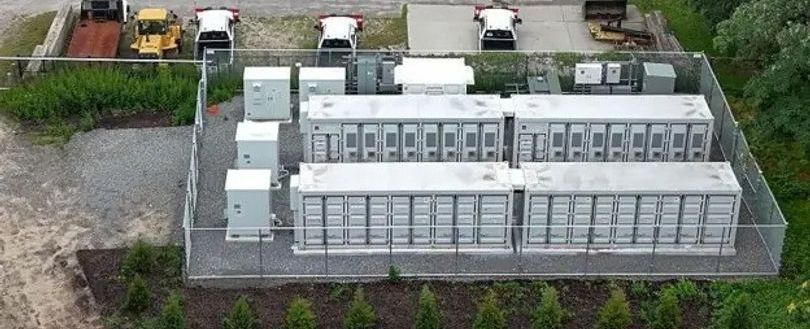
‘We are Playing with Fire’: Growing Concerns Over Battery Storage Safety
Like it? Share it!
11 September 2025
Robert Holden fears the consequences of battery storage developments in New York City.
"It makes absolutely zero sense why, now, these facilities are being sited practically in people's backyards, and next to gas stations, all over Staten Island," says the city councillor.
"Simply put, it is not just a bad policy, but a dangerous one, and the city is literally playing with fire by allowing this to happen."
Holden is referring to the rise of battery energy storage system (BESS) centres – large-scale sites using lithium-ion batteries, similar to those found in laptops and electric vehicles. These batteries are stored by the thousands in large metal containers.
Global Growth of Battery Storage
BESS facilities are becoming more common worldwide. In Europe alone, 1.9 gigawatt-hours of storage capacity was installed last year, according to SolarPower Europe – enough to power around 4,000 homes.
Demand for such storage is set to soar. To reach net zero by 2030, energy from renewables such as wind and solar must be stored and delivered when required, for instance, during peak evening demand.
"For the moment, in the European Union, what we are looking at is that we should increase battery deployments by a factor of 10," explains Driese Acke, deputy chief executive of SolarPower Europe. With around 75 gigawatt-hours currently installed, that figure would need to rise to 750 by 2030.
Alternatives – But Limited Use
Robert Dryfe, professor of physical chemistry at the University of Manchester, points out that alternatives exist. These include cryogenic storage – using liquid air that expands into gas to drive turbines – and hydropower systems that release water between reservoirs.
However, he describes both as "fairly niche devices". "So really to keep pace with the increasing deployment of renewables it's hard to see beyond electrochemical storage mechanisms," he adds.
Fire Risks Remain a Major Concern
Despite their role in supporting renewable energy, BESS technology is not without risks. Fires remain the biggest issue.
-
In Essex, a BESS fire earlier this year took almost 24 hours to extinguish.
-
In Liverpool in 2020, a similar fire burned for 59 hours.
-
In January, one of the world’s largest BESS plants in northern California caught fire, leading to the evacuation of 1,500 people and the closure of a major highway.
Such fires are typically caused by thermal runaway, a chain reaction triggered by short-circuits, defects, or damage. This can lead to flammable gases being released and, in some cases, explosions. With millions of battery cells housed together, the risk of fire spreading is significant.
Even when contained, fires can release pollutants into the air and water. A US review of large-scale BESS fires since 2012, however, found that emissions were largely confined to the immediate area.
Local Opposition in the UK
In Scotland, residents are opposing a planned BESS development by Blackford Renewables in Rothienorman, Aberdeenshire.
"They don't have any consideration for the residents that live outside their red line around their property, they don't take the residents into consideration for flood risk or fire," says campaigner Marguerite Fleming.
In response, a company spokesperson said:
"We take local concerns about fire safety very seriously, and we are committed to maintaining the highest safety standards through the use of advanced technology, fire safety systems and close coordination with emergency services."
Wider Challenges
Prof Dryfe warns that risks are not confined to BESS sites alone, but also extend to recycling facilities where batteries are dismantled at the end of their life. "Recycling's obviously a good thing, but taking batteries apart isn't a risk-free process, and fires can start there," he notes.
Concerns also extend beyond fire safety. Issues include the environmental and humanitarian impact of mining materials such as cobalt, as well as challenges with national grids coping with the rapid rollout of storage facilities.
Calls for Stronger Regulation
Industry experts are urging harmonised international standards.
"From our point of view, it's important to have it harmonised as far as possible, because certainly in the European Union there is no such thing as an EU-wide standard for the quality and maintenance of battery assets," says Mr Acke. "It is all organised on a national level, which means that the EU is not actually a single market as it's meant to be for battery energy storage systems. And that's one of the reasons that big deployments are going a bit slower than they should be."
While international standards are not yet in place, countries including China, the US, the UK and Australia are developing technical guidelines.
Balancing Safety With Necessity
Although fire risks remain, safety measures are improving. Newer systems are equipped with advanced suppression technologies and more fire-resistant chemistries.
Prof Dryfe believes the growth of storage is unavoidable:
"We are using more renewable energy, and that means more grid scale storage – and so basically I don't think we've got any choice."
View the source.
Our eNews provides regular insight into industry trends, news headlines, and product and service information. For more articles like this Subscribe to our enews.
Related news
Related resources
-
Passenger Service Vehicle - Guidance Note
05 September 2023
